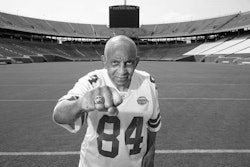The Other Club Scene
From aikido to yoga, club sports offer students lessons in not only sportsmanship but diversity as well.
By Noah Davis
Jordan Amanda Holden arrived at Syracuse University hoping to find her own niche on campus. The freshman international relations major never dreamed she would join a group that performed a South Asian dance called the Bhangra. Yet, at a fair showcasing club sports, Holden saw the Syracuse Orange Bhangra dancers and was hooked.
“I had never seen it before, but I saw them do the dance, and I knew I wanted in,” Holden says. She tried out and made the team, joining two girls of Pakistani descent, two of Indian, one from Bangladesh and another from Singapore. Her new teammates were different from Holden’s friends in her hometown of Charlotte, N.C., but being part of such a diverse group was exciting, she says.
There are countless stories like Holden’s. At colleges nationwide, students from diverse racial, cultural and socioeconomic backgrounds meet and befriend each other under the auspices of club sports. Adam Pruett, the recreational sports coordinator at the University of California, Los Angeles, says any cultural uneasiness is overcome by the students’ shared passion for the particular activity.
“The students rally around the sport that they love,” he says. “It’s when they are playing, and then afterwards when they are spending time together, that they discover their similarities.”
Ben McPolin, a student at the University of Southern California and a member of the school’s marathon club, agrees. “On the team, we have students who hail from every continent, and kids from all over the United States. But we’re all like-minded individuals,” says the Cleveland native. “You have to be a certain level of crazy” to run a marathon.
Every Sunday, the team goes on a run of up to 22 miles. These excursions are a perfect time for bonding, McPolin says. “You get really bored if you just stay in your world for three hours. Without music and a running partner, I’d probably go nuts.
We also sponsor Saturday night carbo-loading dinners, where we get together and eat massive amounts of pasta.”
Like members of almost any team sport, the students involved in nontraditional club sports often say the camaraderie they develop extends beyond the playing field. Nicola Mootoo, a native of Trinidad and Tobago and a member of the Dartmouth College Cricket Club, says he’s developed an interest in other countries because of his interaction with the other foreign students in the club. “We’re all following the international cricket scene. So when the West Indies is playing South Africa, I’m always in touch with Chris [Scholtz, a teammate originally from South Africa]. You get to be more interested in other countries and their states of affairs.”
And in the cases of cricket, Bhangra and other club sports, participation often means learning about the cultures behind the sports. Although cricket is played around the world, there is a huge British influence on the game, which Scholtz says is quickly apparent to new club members. Similarly, Sulman Aziz Mirza, the coach of Syracuse’s Bhangra dance team, says learning the history behind the dance is almost a requirement.
“The dance comes from the state of Punjab [a region between India and Pakistan]. I tell the girls the basic information about the song so they aren’t just dancing blindly,” she says.
Beyond learning about the culture of the sport, club members are often exposed to the cultural differences among their teammates. Holden says she enjoys learning about her teammates’ origins.
And although her teammates have all lived in the United States their entire lives, Holden says she occasionally has to explain why classes are cancelled for certain holidays.
Gina Coleman, the dean of students at Williams College in Massachusetts and the coach of the women’s rugby team, the school’s most diverse club sport, believes that the bonding that occurs on a club team is similar to that which develops on the varsity level. “The common point is that they are all involved in a particular sport,” she says.
But club sports are inherently different from their varsity counterparts because more students can participate. The vast majority of UCLA’s undergraduates could not play on the football team, but they can join the archery team. Team members teach a class for those who want to learn the sport. One member of UCLA’s archery club even became an alternate for the U.S. national team.
At Williams, Coleman’s rugby squad provides girls new to the sport an opportunity to play. “Rugby is welcoming in that very few women have ever played prior to coming to college,” Coleman says. “You can build your own existence within the team because you don’t have to come with a skill set already in existence. I grew up in abject poverty in the Bronx … I thought you needed a horse to play.”
Not only are club sports more accessible than varsity sports, there are simply more of them. Syracuse, for example, offers 19 varsity sports but boasts more than 50 clubs, from aikido to yoga.
USC also has 19 varsity sports, but 42 club sports. McPolin at USC says there are 116 students on the e-mail list for the marathon club. While only 68 ran the L.A. Marathon in March, that number rivals the amount of football scholarships available at USC.
With so many students involved, meeting and befriending a peer from a different background is almost guaranteed. “I really doubt these girls would have met if it weren’t for the team,” says Mirza at Syracuse, and Holden agrees. For Holden, however, the bond extends beyond the dance floor, as she will room with one of her teammates next year.
The freshman has even become something of an ambassador for her adopted sport. Holden says it took a while to explain Bhangra to her family and friends, but “now, they think it’s really cool.” In fact, some of her friends are considering trying out for the team next year.
© Copyright 2005 by DiverseEducation.com


















